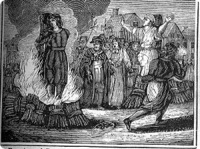Difference between revisions of "Witch-hunt"
m (Text replacement - "http://nordan.daynal.org" to "https://nordan.daynal.org") |
m (Text replacement - "http://" to "https://") |
||
| Line 1: | Line 1: | ||
[[File:lighterstill.jpg]][[File:Witch-Burning.jpg|right|frame]] | [[File:lighterstill.jpg]][[File:Witch-Burning.jpg|right|frame]] | ||
| − | *[ | + | *[https://en.wikipedia.org/wiki/19th_century 1885] |
==Definitions== | ==Definitions== | ||
| − | *1: a searching out for [[persecution]] of persons accused of [ | + | *1: a searching out for [[persecution]] of persons accused of [https://en.wikipedia.org/wiki/Witchcraft witchcraft] |
*2: the searching out and deliberate harassment of those (as [[political]] opponents) with unpopular views | *2: the searching out and deliberate harassment of those (as [[political]] opponents) with unpopular views | ||
==Description== | ==Description== | ||
| − | A '''witch-hunt''' is a search for witches or evidence of witchcraft, often involving [[moral]] [[panic]], mass hysteria and [ | + | A '''witch-hunt''' is a search for witches or evidence of witchcraft, often involving [[moral]] [[panic]], mass hysteria and [https://en.wikipedia.org/wiki/Lynching lynching], but in historical instances also legally [[sanctioned]] and involving official witchcraft [[trials]]. The [https://en.wikipedia.org/wiki/Witch_trials_in_the_Early_Modern_period classical period of witchhunts] in Europe and North America falls into the [https://en.wikipedia.org/wiki/Early_Modern_period Early Modern period] or about 1480 to 1750, spanning the upheavals of the [https://en.wikipedia.org/wiki/Protestant_Reformation Reformation] and the [https://en.wikipedia.org/wiki/Thirty_Years%27_War Thirty Years' War], resulting in an estimated 40,000 to 60,000 executions. |
<center>For lessons on the related [[topic]] of '''''[[Persecution]]''''', follow [https://nordan.daynal.org/wiki/index.php?title=Category:Persecution '''''this link'''''].</center> | <center>For lessons on the related [[topic]] of '''''[[Persecution]]''''', follow [https://nordan.daynal.org/wiki/index.php?title=Category:Persecution '''''this link'''''].</center> | ||
| − | The last executions of people [[convicted]] as witches in Europe took place in the 18th century. In the Kingdom of Great Britain, witchcraft ceased to be an act punishable by [[law]] with the [ | + | The last executions of people [[convicted]] as witches in Europe took place in the 18th century. In the Kingdom of Great Britain, witchcraft ceased to be an act punishable by [[law]] with the [https://en.wikipedia.org/wiki/Witchcraft_Act_of_1735 Witchcraft Act of 1735]. In Germany, [[sorcery]] remained punishable by law into the late 18th century. Contemporary witch-hunts are reported from Sub-Saharan Africa, India and Papua New Guinea. Official legislation against [https://en.wikipedia.org/wiki/Witchcraft witchcraft] is still found in Saudi Arabia and Cameroon. |
| − | The term "witch-hunt" since the [ | + | The term "witch-hunt" since the [https://en.wikipedia.org/wiki/1930's 1930s] has also been in use as a [[metaphor]] to refer to [[moral]] [[panics]] in general (frantic [[persecution]] of [[perceived]] [[enemies]]). This usage is especially associated with the [https://en.wikipedia.org/wiki/Second_Red_Scare Second Red Scare] of the [https://en.wikipedia.org/wiki/1950's 1950s] (the [https://en.wikipedia.org/wiki/McCarthyist McCarthyist] persecution of [[communists]] in the United States).[https://en.wikipedia.org/wiki/Witch_hunt] |
[[Category: Law]] | [[Category: Law]] | ||
[[Category: Religion]] | [[Category: Religion]] | ||
Latest revision as of 02:41, 13 December 2020
Definitions
- 1: a searching out for persecution of persons accused of witchcraft
- 2: the searching out and deliberate harassment of those (as political opponents) with unpopular views
Description
A witch-hunt is a search for witches or evidence of witchcraft, often involving moral panic, mass hysteria and lynching, but in historical instances also legally sanctioned and involving official witchcraft trials. The classical period of witchhunts in Europe and North America falls into the Early Modern period or about 1480 to 1750, spanning the upheavals of the Reformation and the Thirty Years' War, resulting in an estimated 40,000 to 60,000 executions.
The last executions of people convicted as witches in Europe took place in the 18th century. In the Kingdom of Great Britain, witchcraft ceased to be an act punishable by law with the Witchcraft Act of 1735. In Germany, sorcery remained punishable by law into the late 18th century. Contemporary witch-hunts are reported from Sub-Saharan Africa, India and Papua New Guinea. Official legislation against witchcraft is still found in Saudi Arabia and Cameroon.
The term "witch-hunt" since the 1930s has also been in use as a metaphor to refer to moral panics in general (frantic persecution of perceived enemies). This usage is especially associated with the Second Red Scare of the 1950s (the McCarthyist persecution of communists in the United States).[1]
